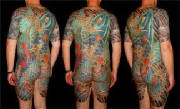|

In 1595, the Spanish explorer Mendana discovered the Polynesian Islands of Fenua Enana and baptized
them the Marquises Islands. But the discovery of Polynesian tattoos would not occur until 1767 when Captain Samuel
Wallis sailed to the Marquises Islands and noticed a universal custom among the Polynesian men and women to have their buttocks
and the back of their thighs painted with thin black lines representing different figures.
|
|
|

It is said that sailors would have a tattoo
of a chicken on one foot and a pig on the other foot to protect them from drowning.
|
|
|

William Dampier of England brought tattooing
back to the west when he brought Prince Giolo, a heavily tattooed Polynesian man back to London, England and put him on exhibit.
He was the first of many to be put on public display at fairs and circuses.
|
|
| |
|
|

The Japanese body suit originated as a reaction to strict laws concerning conspicuous consumption because
at that time only royals or the wealthy were allowed to have such elaborate tattoos.
|
|
|

Captain Cook revived tattooing in London when he returned from his explorations to the South Pacific
with Omai, a heavily tattooed Polynesian man.
|
|
| |
|
|

The Maorian women of New Zealand had tattoos around the nose and lips to keep their mouths and
chins from becoming wrinkled.
|
|
| |
Next
|
| |
|
| |
|
| |
|
| |
|
| |
|
| |
|
| |
|
| |
|
| |
|
| |
|
| |
|

